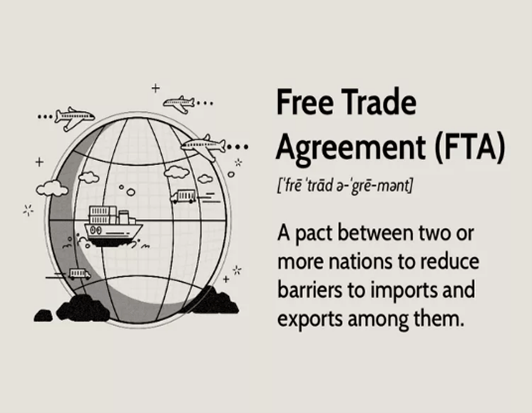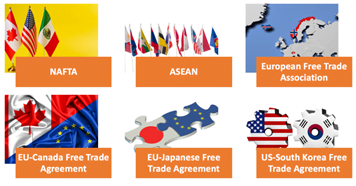Governance, International Relations
Context: In recent times, the Indian government has been actively pursuing free trade agreements (FTAs) with a wide range of countries.
About Free Trade Agreement (FTA):


- A free trade agreement is a pact between two or more nations to reduce barriers to imports and exports among them.
- Goods and services can be bought and sold across international borders with little or no government tariffs, quotas, subsidies, or prohibitions to inhibit their exchange.
- The concept of free trade is the opposite of trade protectionism or economic isolationism.
Relationship Between Multilateralism and FTA:
- Article 1 of GATT (General Agreement on Tariffs and Trade) (about Most Favoured Nation) states that “any advantage, favour, privilege, or immunity granted by any contracting party to any product originating in or destined for any other country shall be accorded immediately and unconditionally to the like product originating in or destined for the territories of all other contracting parties.”
- However, derogations from this MFN principle are permitted for forming FTAs under specific conditions as per the following provisions of the WTO Agreements:
- FTA members shall not erect higher or more restrictive tariff or non-tariff barriers on trade with non-members than existed prior to the formation of the FTA.
- Elimination of tariffs and other trade restrictions be applied to “substantially all the trade between the constituent territories in products originating in such territories.”
- Elimination of duties and other trade restrictions on trade within the FTA to be accomplished “within a reasonable length of time,” meaning a period of no longer than 10 years.
Different Types of Economic Engagements:
- Preferential Trade Agreement (PTA): In a PTA, two or more partners agree to reduce tariffs on an agreed number of tariff lines. The list of products on which the partners agree to reduce duty is called a positive list. India MERCOSUR PTA is such an example. However, in general PTAs do not cover substantially all trade.
- Free Trade Agreement (FTA): In FTAs, tariffs on items covering substantial bilateral trade are eliminated between the partner countries; however, each maintains an individual tariff structure for non-members.
- For example India – Sri Lanka FTA.
- Common Market: Integration provided by a Common market is one step deeper than that by a Customs Union.
- A common market is a Customs Union with provisions to facilitate free movements of labour and capital, harmonize technical standards across members etc.
- For example The European Common Market is an example.
- Economic Union: Economic Union is a Common Market extended through further harmonization of fiscal/monetary policies and shared executive, judicial & legislative institutions.
- European Union (EU) is an example.
- Comprehensive Economic Cooperation Agreement (CECA) and Comprehensive Economic Partnership Agreement (CEPA): These terms describe agreements which consist of an integrated package on goods, services and investment along with other areas including IPR, competition etc.
- The India Korea CEPA is one such example and it covers a broad range of other areas like trade facilitation and customs cooperation, investment, competition, IPR etc.
- Custom Union: In a Customs union, partner countries may decide to trade at zero duty among themselves, however they maintain common tariffs against the rest of the world.
- Example Southern African Customs Union (SACU) amongst South Africa, Lesotho, Namibia, Botswana and Swaziland.
- The European Union is also an outstanding example
Significance of FTAs:
- FTAs give businesses and consumers improved access to a wider range of competitively priced goods and services, new technologies, and innovative practices.
- FTAs help to obtain more benefits from foreign investment.
- FTAs promote regional economic integration and build shared approaches to trade and investment between the trading partners.
- FTAs can deliver enhanced trade and investment opportunities that contribute to the economic growth of less-developed economies.
- FTAs support stronger people-to-people and business-to-business links that enhance overall bilateral relationships with FTA partners.
- FTAs can continue to provide additional benefits to the trading partners over time, including via in-built agendas that encourage ongoing domestic reform and trade liberalisation.
Major Challenges in adopting FTAs:
- Protectionist Tendencies: Moves such as plans to raise import duties on “non-essential items”, will only expose the government to the charge of being protectionist.
- The first two decades after 1991-92 saw a steep decline in tariff rates.
- The trend, however, has been reversed under the ruling government with the average applied import tariff actually rising. But still challenges remain.
- Demographic dividend: These Non-tariff issues could pose hurdles for India in reaping the gains of its comparative labour advantage.
- Shift of focus: Wrapping up these FTA talks could narrow soon given that India’s focus would shift to the series of events linked to India’s G20 Presidency.
- Influential lobbies can delay it more: Political lobbying from influential lobby groups such as farmer unions and the auto sector could intensify.
- Priority to non-tariff issues: In much of the negotiations currently under discussion, climate action, carbon emissions and labour issues are taking precedence over trade issues.
- GSP (Generalised System of Preferences): Currently, we may benefit from the GSP but if they come in a non-tariff barrier by citing labour or environment, then it becomes an issue citing standards, adjustments, child labour as reasons.
- India had been a beneficiary of the US’ GSP programme since November 1975, under which beneficiary countries are allowed to export thousands of products to the US without the added burden of duties.
- Recessionary conditions: These could potentially offer partner countries a handle to trigger non-tariff protectionist measures as developed nations stare at recessionary conditions.
- Environmental issues: Developed countries such as the US have brought up the issue of carbon emissions in the process of manufacturing melted steel as a non-tariff-related issue.
- India mostly produces steel generated from iron ore which comes from mining.
- Most developed countries have resorted to methods to generate it from scrap which results in lower carbon emissions. Thus, there may be a levy of carbon adjustment tax.
- Carbon Border Adjustment Mechanism: The European Union has proposed CBAM to tax carbon-intensive products, such as iron and steel, cement, fertiliser, aluminium and electricity generation from 2026.
- EU importers will buy carbon certificates corresponding to the carbon price that would have been paid, had the goods been produced under the EU’s carbon pricing rules.
Way Forward:
- Towards Open and Competitive Economy: The trade policy framework must be accompanied by economic reforms that result in an open, competitive, and technologically advanced economy.
- Therefore, country looking for FTAs must focus on inclusion of entrepreneurs in global economic networks that will also allow them to pursue greater financial security.
- Strengthening MSME Sector: With a contribution of about 29% to the GDP and 40% to international trade, MSMEs are the key players in achieving the ambitious export targets.
- It is important for India to link Special Economic Zones with the MSME sector and incentivize small businesses.
- Enhancing Domestic Base: India needs to strengthen its domestic manufacturing base in value-added products like engineering goods, electronic products, drugs and pharmaceuticals, textiles, and agriculture machinery, that could be used to boost exports.
- Infrastructural Evolution: A robust infrastructure network – warehouses, ports, testing labs, certification centers, etc. will help Indian exporters compete in the global market.
- It also needs to adopt modern trade practices that can be implemented through the digitisation of export processes. This will save both time and cost.
- Scrutiny of FTAs: The Committee on Commerce should be tasked with scrutinizing FTAs, discussing different aspects of agreements and negotiations, thus ensuring executive accountability to the legislature.
Source: Indian Express
Previous Year Question
Q.1) European Stability Mechanism’, sometimes seen in the news, is an (2016)
- agency created by EU to deal with the impact of millions of refugees arriving from Middle East
- agency of EU that provides financial assistance to eurozone countries
- agency of EU to deal with all the bilateral and multilateral agreements on trade
- agency of EU to deal with the conflicts arising among the member countries














